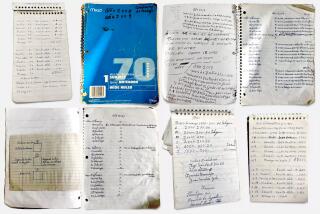Journey of Torah Found in Drawer Bespeaks Ties of Family and Faith : Rosh Hashanah: Written a century ago, hand-lettered parchment scroll accompanied emigres as they fled oppression in a Belarussian hamlet and eventually settled in Iowa.
SEATTLE — The puzzlement in my brother’s voice caught me up short.
“Tim, can you come in here a minute? I want to show you something.”
Kalman and I had just arrived in Sioux City, Iowa, to prepare for the death of our mother, Merry Gralnek Klass, after an eight-month series of strokes. In the bedroom where my brother was staying, he had found a small Torah in a built-in drawer.
Documents showed that the painstakingly hand-lettered parchment scroll was brought to Marshalltown, Iowa, in 1909 by our grandmother, Tuva Kastelman Gralnek, who died when Mom was a girl.
After years in storage, the little Torah is now one of three at Temple B’nai Torah, the Mercer Island synagogue Kal and I attend. While the parchment of most Torahs is about 28 inches high, ours is about half that size.
For me, the most moving times it is read are at Rosh Hashanah and Yom Kippur, the 10-day period of the High Holy Days, which begin at sundown Monday. The Torah is read at children’s services. That’s when I tell the youngsters, including my daughters, Dustin Rose, 8, and Tatanya Renee, 7, how it came to us.
A Torah, the first five books of the Bible inscribed in a special Hebrew script, is the most holy object in Judaism.
Torahs as small as ours are uncommon, and rarely can any Torah be traced back a century within one family. The late Rabbi Jacob Singer, founder of Temple B’nai Torah, owned a Torah of similar size that had been used in Warsaw to prepare boys for bar mitzvah, the ceremony of achieving full status within the Jewish community at age 13.
The Holocaust Museum in Washington, D.C., contains a display of Torah fragments from areas overrun by the Nazis. If not for my grandmother, for whom I am named, ours might have met a similar fate.
It was written around 100 years ago, possibly by a cousin of our grandfather, Kolman Gralnek, in or near a southwestern Belarussian hamlet called Mikolaiv where the family supported a synagogue.
Facing conscription into the notoriously anti-Semitic Russian Army, Kolman Gralnek and his older brother, Moishe, left their wives and children one night in 1904 and made their way to the United States.
Five years later, they had earned enough by carrying bags of coal and other backbreaking labor in New York to send for their families.
With help from the Hebrew Immigrant Aid Society, they resettled as pack peddlers in central Iowa, Moishe in Newton and Kolman in Marshalltown.
My grandmother insisted on bringing the little Torah so her children would have at least one source of Jewish instruction.
She, her sister-in-law and their children arrived at Ellis Island on the Fourth of July in 1909.
My mother, the youngest of nine, was born in 1917. The Torah remained in the household until 1939, when Sons of Israel Congregation was organized.
Born in 1948 in Sioux City, I attended services a few times in Marshalltown and must have seen the little Torah. Never was I told it was part of our family heritage.
When Sons of Israel was disbanded in 1985, two larger Torahs were sent to other synagogues.
The same would have happened to ours, but my aunts Esther and Tillie Gralnek retrieved the small scroll with its original vestments at the last minute and took it to Mom for safekeeping.
She never told any of us. By the time of my brother’s discovery in 1989, she was no longer able to speak. Days later, she was dead.
Sioux City’s Jewish community is following the same pattern of inexorable evaporation as in Marshalltown and most of the rest of the nation’s heartland.
Kal and I live in Seattle. One sister lives on Mercer Island but attends a different synagogue. The second is in Santa Cruz, Calif. The third, Kal’s twin, is in Bethesda, Md.
We once had a dozen aunts, uncles and cousins in Sioux City and nearly 20 others elsewhere in Iowa. All that remain among our family are our father in Sioux City, two aunts in Marshalltown and a cousin in Des Moines.
After Mom’s funeral, our aunts decided ownership of the Torah would pass to my brother, who is named for our grandfather.
It is used regularly at Temple B’nai Torah, and we take it to read at each family bar or bat mitzvah.
All five of us have read from it.
At our synagogue, Rabbi James L. Mirel enjoys being able to extend participation to those without the physical strength to lift a full-size Torah.
More to Read
Sign up for Essential California
The most important California stories and recommendations in your inbox every morning.
You may occasionally receive promotional content from the Los Angeles Times.










